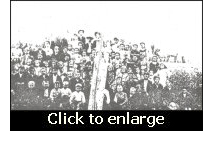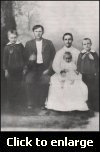
Byrd (Byron)
First called Byron, this community came intio being in the early 1800s soon after Texas had gained her independence from mexico - located on a league of land about eight miles southwest of present Ennis. H. L. Parker, first to locate here, controlled the sale of this fertile back land for Morgan L. Smith of Newark, New Jersey who had purchased the league fosight unseen, for fifty cents an acre, from the republic of Texas. Dan Faulk, another early settler, traded the property he had in the Galveston area for five hundred acres here. He, too, had never seen his purchase until he arrived in this section of Texas.
The first store was built by Rube Warren who located it on the stage coach route from Dallas to the coast. It became an overnight stop for travelers and also a replacement point for tired horses. The original stop was located on the large acreage now owned by members of the late Sam Armstrong family. Other early settlers were trhe William I. Champ and Gensch families - brothers William, Ed and Val.
In 1886, James Thomas Colvin moved from the Crisp community to Byron. He later bought more land from William champ on which the store and post office were located. Members of the Colvin family still live in the old Champ house in 1972. James Colvin also operated the village blacksmith shop and carried the mail.
Bryon post office was established Sept. 6, 1894, with W. I. champ as postmaster and was housed in a store owned by Thomas J. Kelsey, who became postmaster March 31, 1902. The office was discontinued Aug. 4, 1905./
 Then the post office
closed, the citizens renamed the community Byrd in honor of Charlie Byrd,
who donated the land for the community's first school. - a large one room
building which soon became the center of all social activities and a place
where Union church services were held. Miss Bessie Sharpe, Cebe Newman
and wife were among the early teachers, as was D. Greenstree, who later became
postmaster in Ennis. Rev. Tooley, a Methodist circuit rider, Rev. Wright,
Brother Kelly, Brother Trice and Sister Rutherford helped conduct worship
services held in the school building until another meeting place could
be built.
Then the post office
closed, the citizens renamed the community Byrd in honor of Charlie Byrd,
who donated the land for the community's first school. - a large one room
building which soon became the center of all social activities and a place
where Union church services were held. Miss Bessie Sharpe, Cebe Newman
and wife were among the early teachers, as was D. Greenstree, who later became
postmaster in Ennis. Rev. Tooley, a Methodist circuit rider, Rev. Wright,
Brother Kelly, Brother Trice and Sister Rutherford helped conduct worship
services held in the school building until another meeting place could
be built.
Plans to build the arbor were formulated June 1, 1897 under the direction of R. A. Owens, Robert L. Carter, R. H. Owens, J. P. Odom, Thomas J. Kelsey, J. P). Porter and J. J. Mays. William Gensch sold the land for the arbor and deeded the property to R. L. Carter, chairman of the board. The selected site was on a beautiful knoll surrounded by large threes, assurring a cool place for meetings. It was a large open sided building with a shingled roof, and an alcove at the front which protected the organ and other supplies. Cost wasf $132.00. Cash donations were given by families of the community and when completed, it was free of all debt, with a balance of eighty cents.
One early physician was Dr. Webb Johnson who also owned a grocery store and drug store. Dr. T. M. Matheny served his apprenticeship as a pharmist in the drug store and later cared for Dr. Johnson for two years during his last illness. He practiced medicine in the Byrd community and later moved to Bardwell. Two of Dr. Johnson's daughters, Mrs. Jim Idlett and Mrs. Luther Bates, stilled lived in the area a number of years ago. Another early day doctor was A. J. Heter, the father of Dr. James R. Jeter, a prominent physician in Ennis. and Drs. Bren and Conally.
The Woodman of the World Hall was the place where elections were held. Robert L. Hodge served many years as election judge for this large precinct.
Early settlers were Martin and Tom Duke, J. J. Mays, J. T. Holcomb, Robert L. Carter, Tom Kelsey, John N. Culbert, Jim Thornton, L. T. St. Clair and Josh Brock. When the Trinity and Brazos Valley Railway was built through the community in 1907, Josh Brock gave the right of way through his extensive holdings for a lifetime pass on the railroad for his family.
 Other families were Lewis Whatley
and wife, Mary Caroline, Red Davis, Harry Hester, Ed Whatley, Gus Rumbo,
Alec Hill, N,. W. Worthy, Luther Bates, Doc Greer, C. W. Dausey, Doc Ling,
Jim Idlett, L. T. StClair and E. P. Gerron. The latter family came
from Marshall County Alabama in 1890 by train to Dallas where he bought a
covered wagon and sullies for the trip to Ellis County, arriving in the Byra
community in March 1890. The German brothers owned a grocery store
and the village barber shop.
Other families were Lewis Whatley
and wife, Mary Caroline, Red Davis, Harry Hester, Ed Whatley, Gus Rumbo,
Alec Hill, N,. W. Worthy, Luther Bates, Doc Greer, C. W. Dausey, Doc Ling,
Jim Idlett, L. T. StClair and E. P. Gerron. The latter family came
from Marshall County Alabama in 1890 by train to Dallas where he bought a
covered wagon and sullies for the trip to Ellis County, arriving in the Byra
community in March 1890. The German brothers owned a grocery store
and the village barber shop.
Robert L. Hodge and wife, Susie, came from Alabana in 1901 and bought the Alec Hill farm where they reared their large family, whose musical talents were shared with a vast acquaintance of friends. A find spring of water, known as Grady Springs, was located on the Hodge farm and served as a source of water for the cattle drives to Kansas markets. Alec Hodge, ason of Robert, owned and operated the last stgore, a grocery, in this once populous area. It chosed in 1968 after his death.
A sister-in-law, Mrsw. Carrie Hodge, was one of the last teachers in the bhyrd school. It closed in 1957 when the puils transferred to Ennis or other districts. The school house became a center for social and civic meetings when the Byrd-Rankin Community Center organized.
By 1933, byrd had an estimated population of fifty, with the same reported until the 1960s. From 1970 to 1990, population was estimated at fifteen. However, many of the early residents and their descendants continue to enjoy life in this qjuiet, peaceful area, unmarked by super highways or shopping centers, yet with early access to these necessarhy facilities in nearby towns and cities.
References:
A Memorial and Biographical History of Ellis County, Texas.
, Lewis Pubvlishing Co. Chicago, Ill. 1892.
Hawkins,et al, History Workshop, History of Ellis County, Texian
Press, Waco, 1972.
Handbook of Texas Online.
Copyright © 2002-2016, Ellis County TXGenWeb. All Rights Reserved.
This page was last modified: Thursday, 01-Jul-2021 13:17:00 MDT